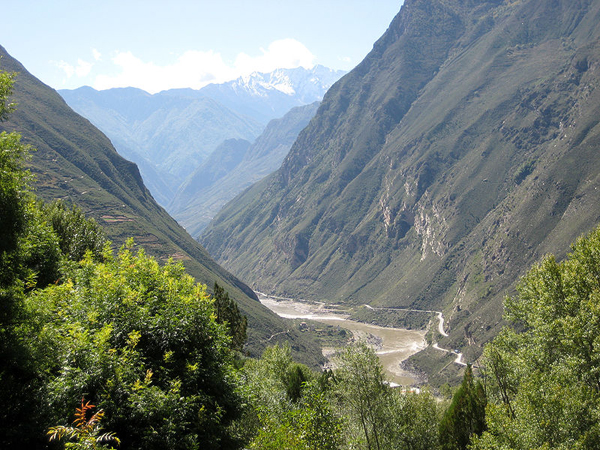Chinese environmental authorities have approved construction plans for what could become the world’s tallest dam, while acknowledging that the project would affect endangered plants and rare fish species.
The 314 meter-high dam (1,030ft) will serve the Shuangjiangkou hydropower project along the Dadu river in south-western Sichuan province, according to China’s state news agency, Xinhua. A subsidiary of Guodian Group, one of China’s five major state-owned power companies, will complete the project over a decade at an estimated cost of £2.9bn.
The dam will be far taller than the 185 meter-high Three Gorges dam along the Yangtze river—the world’s most powerful hydroelectric project—and slightly edge out the current record holder, the 300 meter-high Nurek dam in Tajikistan. The world’s second-tallest dam, the 292 meter-high Xiaowan dam on the Lancang (Mekong) river, is also in China.
China’s environment ministry acknowledged that the dam would have an impact on the area’s highly biodiverse flora and fauna.
“The project will affect the spawning and movement of rare fish species, as well as the growth of endangered plants, including the Chinese yew, which is under first-class state protection,” the ministry said, according to Xinhua.
The ministry proposed counter-measures to mitigate the environmental impact, such as “protecting fish habitats in tributaries, building fish ladders and increasing fish breeding and releasing”, Xinhua reported. The project is still awaiting a final go-ahead from China’s state council.
The Dadu river is a tributary of the 450 mile-long Min river, which cuts through the centre of Sichuan province before joining the Yangtze further south.
Upon completion, the plant will have a total installed capacity of 2GW and produce nearly 8bn KW-hours of energy a year, about twice as much as the Hoover dam in the US.
China’s hydropower development has surged in recent years as the country moves to increase non-fossil energy sources to 15% of its total energy use by 2020. Central authorities approved a controversial cascade of 13 dams on the pristine upper reaches of the Nu (Salween) river in January. The plans had stalled nearly a decade ago under pressure from environmental groups.
Scientists and environmental activists have raised concerns that a profusion of dams in south-west China could increase the area’s risk of natural disasters, such as earthquakes and landslides.
Another hydroelectric project on the Dadu river prompted social unrest in 2004, as tens of thousands of farmers along its banks rioted against plans to relocate them. Authorities responded by halting the Pubugou dam’s construction for a year.

The upper Dadu River, a tributary of the Yangtze River. Photo by: rduta/Creative Commons 2.0.
Original Post:
World’s tallest dam approved by Chinese environmental officials
Related articles
Amazon’s flood/drought cycle becoming more extreme, less predictable

(05/14/2013) The Amazon River’s hydrological cycle has become more extreme over the past two decades with increasing seasonal precipitation across much of the basin despite drier conditions in the southern parts of Earth’s largest rainforest, finds a new study published in Geophysical Research Letters. The research analyzed monthly Amazon River discharge at Óbidos, a point that drains 77 percent of the Amazon Basin, and compared it with regional precipitation patterns.
Rainforest tribe urges Norwegian king to recall energy executive

(05/13/2013) In an unusual bid to stop a series of dams that will flood their rainforest home, a group of tribesmen in Borneo are urging King Harald V of Norway to call one of his subjects home. The subject is Torstein Dale Sjøtveit, a Norwegian citizen who is the CEO of Sarawak Energy, a Malaysian firm that is building several dams in the state of Sarawak. The hydroelectric projects are controversial because they require the forced displacement of indigenous communities and will flood large tracts of rainforest.
Deforestation will undercut effectiveness of rainforest dams

(05/13/2013) Deforestation may significantly decrease the hydroelectric potential of tropical rainforest regions, warns a new study published in Proceedings of the National Academy of Science. The study, used climate, hydrological, and land use models to forecast the impact of potential forest loss on hydropower generation on the Xingu River, a major tributary of the Amazon where the world’s third largest dam — Belo Monte — is currently under construction.
Tribesmen launch ‘occupy’ protest at dam site in the Amazon rainforest
(05/03/2013) On Thursday roughly 200 indigenous people launched an occupation of a key construction site for the controversial Belo Monte dam in the Brazilian Amazon. The protestors, who represent communities that will be affected by the massive dam, are demanding immediate suspension of all work on hydroelectric projects on the Xingu, Tapajós and Teles Pires rivers until they are properly consulted, according to a coalition of environmental groups opposing the projects.
Featured documentary: Damocracy, highlighting the battles over the Belo Monte and Ilisu dams
(04/29/2013) A new short documentary highlights the battles over monster dam projects imperiling local people and wild rivers. Examining the Belo Monte dam in Brazil and the Ilisu dam in Turkey, the documentary argues that such hydroelectric projects cannot be deemed “green” energy as they overturn lives, livelihoods, and ecosystems.
The river of plenty: uncovering the secrets of the amazing Mekong

(04/23/2013) Home to giant catfish and stingrays, feeding over 60 million people, and with the largest abundance of freshwater fish in the world, the Mekong River, and its numerous tributaries, brings food, culture, and life to much of Southeast Asia. Despite this, little is known about the biodiversity and ecosystems of the Mekong, which is second only to the Amazon in terms of freshwater biodiversity. Meanwhile, the river is facing an existential crisis in the form of 77 proposed dams, while population growth, pollution, and development further imperil this understudied, but vast, ecosystem.
Judge halts military-backed dam assessment in Brazil’s Amazon
(04/17/2013) A federal court in Brazil has suspended the use of military and police personnel during technical research on the controversial São Luíz do Tapajós Dam in the Brazilian Amazon. The military and police were brought in to stamp down protests from indigenous people living along the Tapajós River, but the judge decreed that impacted indigenous groups must give free, prior, and informed consent (FPIC) before any furter studies can be done on the proposed dam. However, the decision is expected to be appealed.